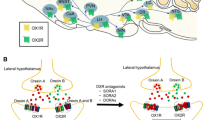Abstract.
Rationale: Orexin-A and orexin-B are hypothalamic neuropeptides derived from a 130-amino acid precursor, prepro-orexin, and are potent agonists at both the orexin-1 (OX1) and orexin-2 (OX2) receptors. Orexin-A has been ascribed a number of in vivo functions in the rat after intracerebroventricular (ICV) administration, including hyperphagia, neuroendocrine modulation and a role in the regulation of sleep-wake function. The in vivo role of orexin-B is not as clear. Objectives: To investigate the behavioural, endocrine and neurochemical effects of orexin-B in in-vivo tests. In a number of experiments, these effects were compared with those of orexin-A. Methods: Experiments were carried out in male, Sprague-Dawley rats with a guide cannula directed towards the lateral ventricle. The effects of orexin-B (ICV) upon grooming behaviour were compared with those of orexin-A. The effects of orexin-B upon the motor activity response to both novel and familiar environments were assessed in an automated activity monitor. Orexin-B was tested upon startle reactivity and body temperature. Further, plasma hormones and [DOPAC+HVA]/[DA] and [5-HIAA]/[5-HT] ratios in six brain areas were measured 40 min post-orexin-B or orexin-A. Results: The clearest behavioural response to orexin-B was increased motor activity in both novel and familiar environments. Orexin-B-induced hyperactivity was blocked by an OX1 receptor antagonist, SB-334867-A, implicating OX1 receptors in this behavioural response. In common with orexin-A, orexin-B reduced plasma prolactin and failed to influence startle reactivity. However, in contrast with orexin-A, orexin-B increased head grooming but failed to cause a robust whole body grooming response or increase plasma corticosterone levels. Further, orexin-B, but not orexin-A, increased plasma TSH and increased hypothalamic and striatal [5-HIAA]/[5-HT] ratios. Conclusions: The present study has demonstrated a number of behavioural, neuroendocrine and neurochemical effects of orexin-B that distinguish it from orexin-A. Further, we have demonstrated a role for OX1 receptors in the actions of orexin-B upon motor activity.
Similar content being viewed by others
Author information
Authors and Affiliations
Additional information
Electronic Publication
Rights and permissions
About this article
Cite this article
Jones, D., Gartlon, J., Parker, F. et al. Effects of centrally administered orexin-B and orexin-A: a role for orexin-1 receptors in orexin-B-induced hyperactivity. Psychopharmacology 153, 210–218 (2001). https://doi.org/10.1007/s002130000551
Received:
Accepted:
Issue Date:
DOI: https://doi.org/10.1007/s002130000551




